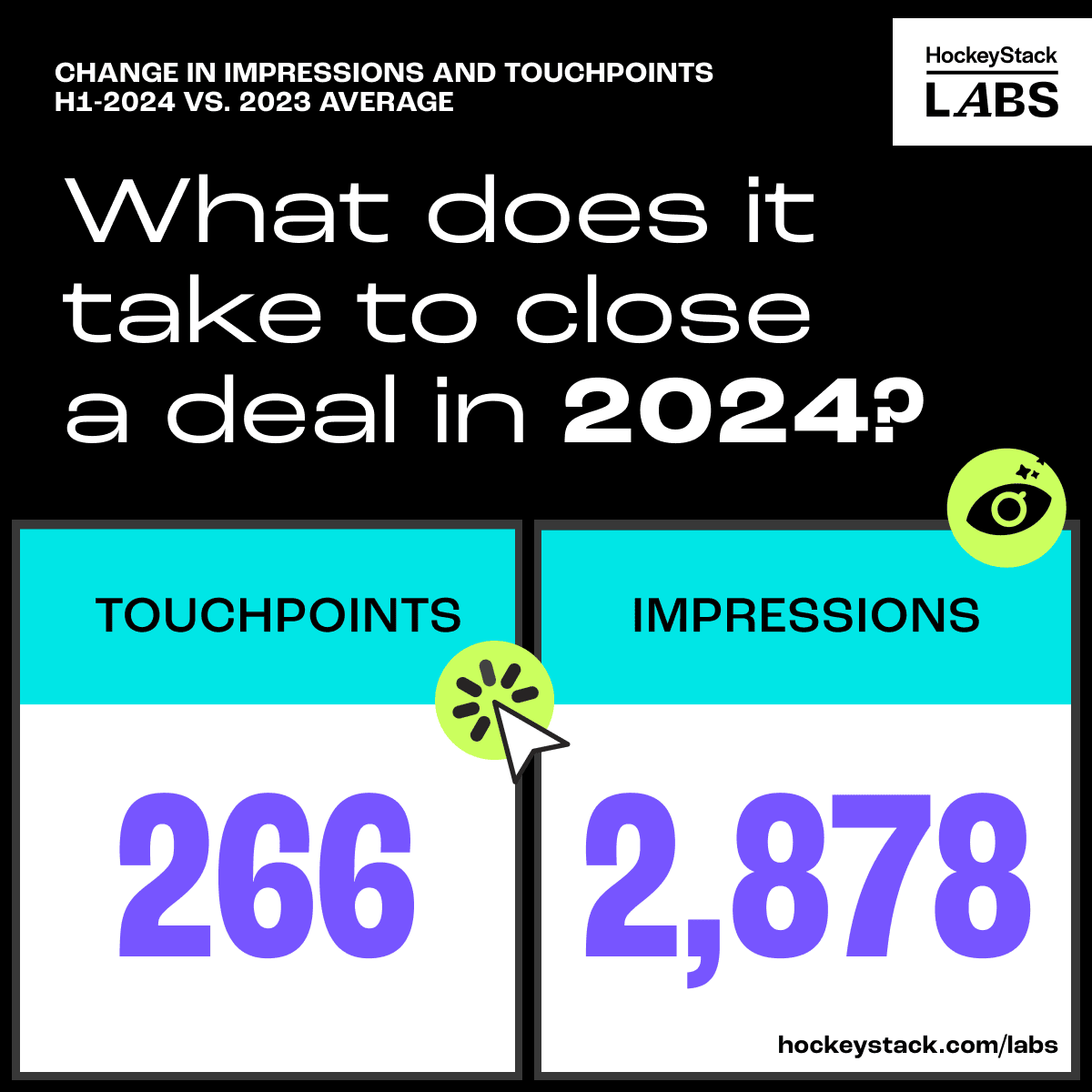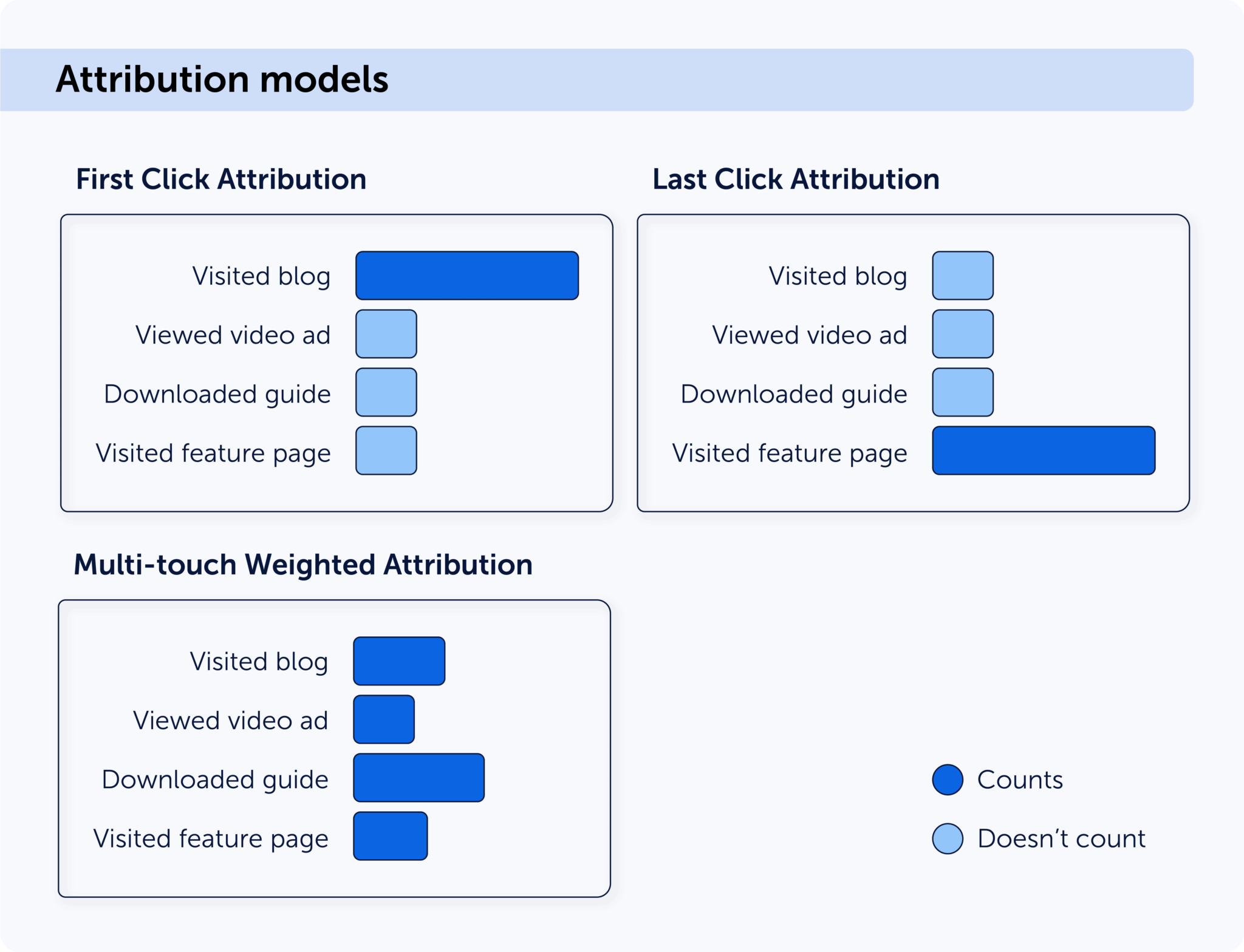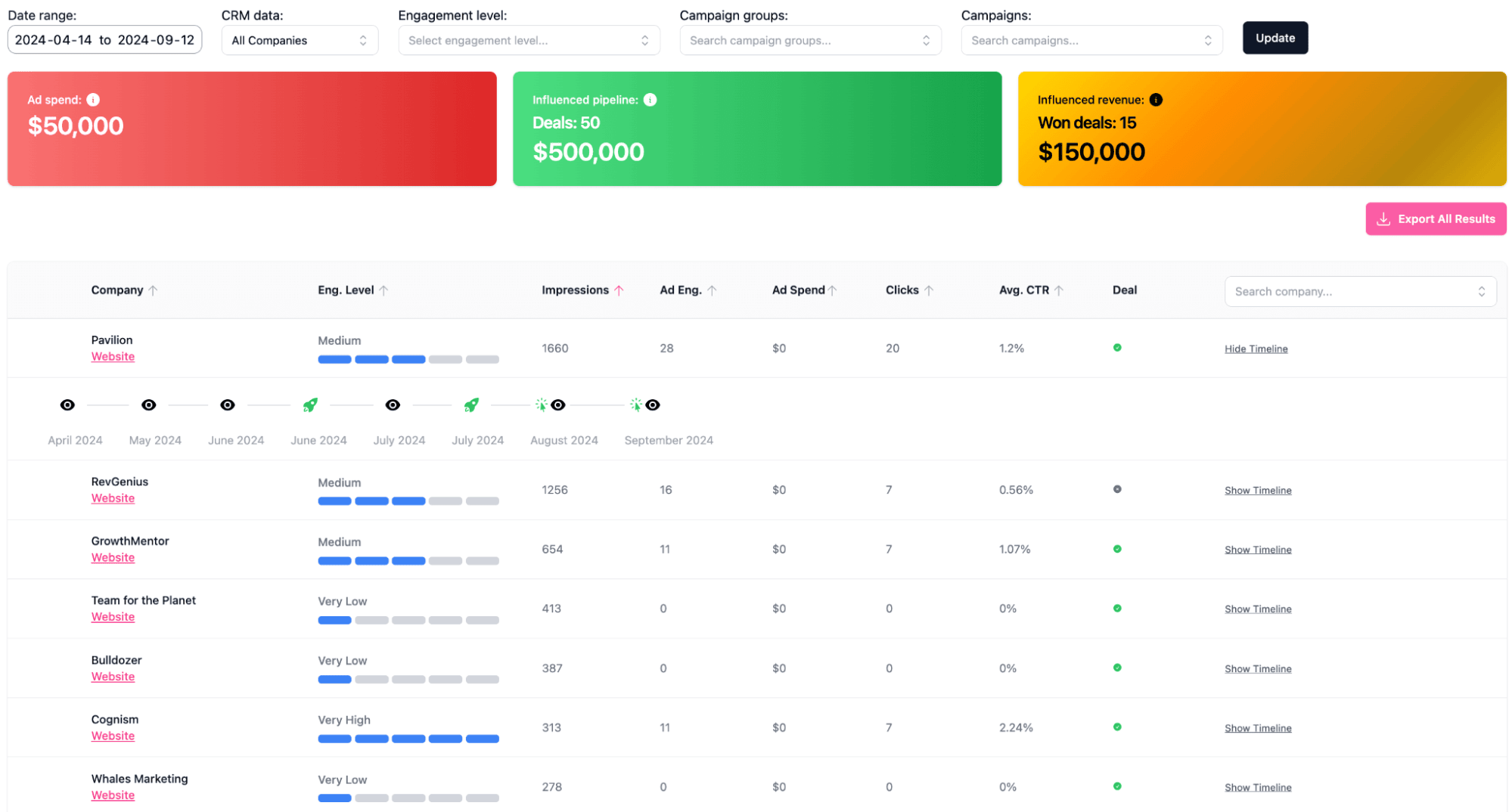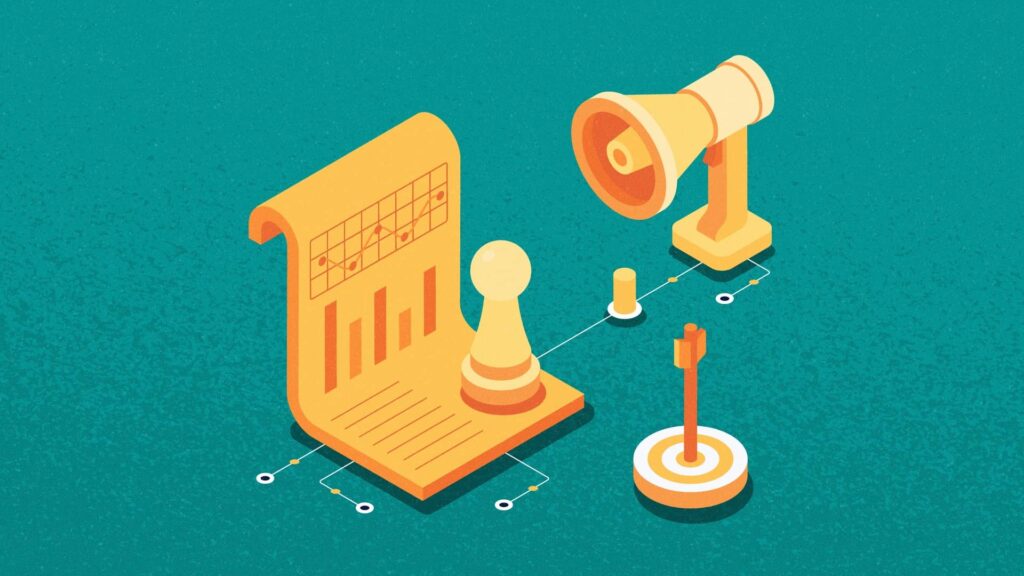The customer journey in B2B SaaS is rarely straightforward — and that makes attribution a huge pain in the SaaS for marketers (and the entire organizations together with them). With multiple decision-makers, longer buying cycles, and numerous touchpoints, traditional attribution models like “last-click” or “single-touch” often don’t work.
Why Traditional Attribution Models Don’t Work for B2B SaaS
For instance, a recent study by HockeyStack found that B2B SaaS companies require an average of 266 touchpoints to close a deal. Is it fair to attribute the conversion to the first or last touchpoint and just ignore the other 265?
Traditional attribution models, such as first-touch or last-touch, were built primarily for B2C environments with short and simple sales cycles. No wonder these models fall short when applied to B2B SaaS.
It’s time to stop using them, or at least considering the new paradigm we live in.

Source: HockeyStack Lab
Studies consistently highlight these problems. According to Demand Gen Report’s 2023 B2B Buyer’s Survey, 67% of B2B buyers engage with more than five pieces of content before making a purchase decision. Which piece of content played the key role?
Meanwhile, Gartner reports that the typical buying group for a complex B2B solution involves 6-10 decision-makers, each with unique perspectives and information needs. When relying on single-touch models, you don’t factor these interactions. And that’s valuable data that can completely change your marketing strategy and campaigns.
Also, the touchpoints should be varied—from ads and whitepapers to in-person demos and follow-up emails. According to Forrester, the number of interactions in a buying journey has recently increased from 17 to 27. In this context, the shortcomings of last-click attribution are clear: it doesn’t account for all the nurturing and educational efforts made throughout the journey.
Let’s sum this up. First-click and last-click attribution models
- miss the impact of multiple touchpoints across the buyer’s journey;
- completely ignore that there are multiple stakeholders;
- fail to capture the role that upper-funnel content, like thought leadership pieces or product webinars, plays in nurturing leads over time.
So, B2B SaaS companies that rely on traditional attribution models risk misallocating resources and focusing on the wrong channels. What do you do with it? Shift to influence-based or multi-touch weighted attribution models.

Effective Attribution Strategies for B2B SaaS
Influence-Based Attribution
Influence-based attribution evaluates how each touchpoint contributed to a conversion.
It accounts for the various channels that help build awareness and trust over time, recognizing the contributions of earlier and middle-stage interactions in a longer buying cycle where no clicks happened, but plenty of plenty of people saw your ads.

“With influence-based models, we can see how different interactions build momentum. It’s a way to track how each touchpoint adds to the overall decision-making process, especially for longer, multi-stakeholder sales cycles.”
How to implement it
- Map the buyer journey: Identify and organize all key interactions that typically occur for a B2B SaaS buyer.
- Set up a scoring system: Rate the importance of touchpoints based on engagement metrics, relevance to decision-making, and where they occur in the journey.
- Use data analytics tools: Platforms like HubSpot or Marketo offer influence-based reporting, where marketers can assign weights to interactions based on importance.
- Ditch the mentality of measuring campaign performance based on clicks. When was the last time you clicked on an ad, really? That doesn’t mean they were ineffective.
The pros and cons of influence-based attribution
Pros
- Offers a comprehensive view of all interactions that contribute to the journey, rather than focusing on one or two specific points.
- Helps optimize early- and mid-stage touchpoints that are often overlooked in simpler models, enhancing buyer engagement across stages.
- Aligns well with complex B2B cycles, where multiple stakeholders influence decisions.
Cons
- They can be costly, especially for companies with smaller budgets.
- May need frequent adjustments to accurately reflect changes in buyer behavior over time.
- Can be challenging to track without specialized software that supports influence-based models.
- Tough to sell to stakeholders. It’s hard to shift mentality in management to understand the influence marketing has beyond legacy attribution models.

A screenshot from Fibbler, a SaaS tool that enables influence-based attribution
Multi-Touch Attribution with Custom Weighting
Multi-touch attribution with custom weighting assigns a different level of importance to each touchpoint in the buyer’s journey. Unlike influence-based attribution, where touchpoints are evaluated qualitatively, custom weighting uses quantitative metrics to assign percentages or scores to touchpoints according to their impact on conversion.

“Single-touch attribution is a bit like giving a single player all the credit for a team win. In B2B SaaS, you have a complex web of interactions that play a role in getting a prospect to the finish line. Without MTA, you’re missing the bigger picture.”
How to implement it
- Define custom weight models: Start with commonly-used models, like U-shaped or W-shaped attribution, then customize based on your specific journey insights.
- Leverage advanced tools: Google Analytics 360 or Bizible allow for custom-weighted attribution models that can be tailored to your buyer journey.
- Test and refine: Regularly review the accuracy of the weightings and adjust based on real-world results.
The pros and cons of multi-touch attribution with custom weighting
Pros
- Provides high data accuracy, allowing a precise understanding of which touchpoints drive conversions.
- Customizable to specific goals, enabling teams to focus on the most impactful interactions.
- Supports optimization at each touchpoint, giving clear insights into where budget and resources are best spent.
Cons
- Complex to set up and maintain, often requiring expertise in data analysis and access to advanced tools.
- Can be rigid if not frequently updated, potentially leading to outdated insights if buyer behavior shifts.
- May overlook nuances that qualitative insights capture, which could affect holistic understanding.
Tactics That Help Succeed in Attribution
1. Leverage Qualitative Insights
Quantitative data only tells part of the buyer’s journey. By adding qualitative insights, like user behavior analysis, you can understand why certain touchpoints perform as they do.
With tools like Mouseflow, you can use session recordings, heatmaps, and funnel tracking, which reveal behavior patterns and help diagnose bottlenecks or areas of interest.
Buyer’s journey questions Mouseflow helps answer:
-
- Which pages and content are most engaging for different buyer personas?
Mouseflow’s scroll and attention heatmaps reveal which sections of a page capture the most attention, helping teams understand what resonates with each persona and guiding content and design improvements. - Where do users drop off in the conversion process?
By using Mouseflow’s funnel analysis feature, marketers can pinpoint exactly where potential customers leave the site. This insight helps identify any friction points and optimize key steps in the journey.
- Which pages and content are most engaging for different buyer personas?
![]()
- What actions do visitors take before making a purchase decision?
Session replays allow teams to watch real interactions with the website, showing specific actions taken by high-intent users. This data illuminates the behaviors that indicate readiness to buy, helping to highlight high-impact touchpoints. - What user pain points could deter conversions?
Identifying friction events like click rage, excessive scrolling, or frequent page exits can reveal frustrations that may prevent conversions.
These insights are invaluable for refining your attribution model by validating quantitative data with user context. Also, they help you with tactics number 2: aligning content with personas and stages.
2. Align Content with Buyer Personas and Stages
Understanding buyer personas and where they are in their journey allows marketers to create content that speaks directly to their needs.
Tailoring content at different stages (awareness, consideration, decision) helps ensure that each touchpoint adds value, making it easier to attribute engagement to specific content types. This alignment also enhances the likelihood of capturing useful data across touchpoints.

3. Encourage Marketing-Sales Alignment
Strong collaboration between marketing and sales ensures a seamless handoff of information, which is essential in multi-touch attribution.
Sales teams can provide feedback on leads and engagement quality, helping marketing teams better assess which touchpoints are most impactful. Regular alignment meetings and shared KPIs are key tactics to achieve this.
4. Continuously Refine and Optimize Metrics
In B2B SaaS, a “set-it-and-forget-it” approach doesn’t work for attribution. Customer behaviors and channels evolve, so your attribution metrics and methods should, too. Regularly review and adjust metrics based on new insights, business goals, and shifts in the customer journey.
This approach keeps your team in sync with what’s currently driving results, enabling you to allocate resources more effectively and achieve stronger marketing and sales alignment.
Conclusion
Attribution in B2B SaaS requires more than just assigning credit to the first or the last click. By moving to an influence-based or multi-touch model, you can better understand how each touchpoint impacts the customer journey. This approach allows you to create more relevant content, make informed budget allocations, and ultimately drive better results.
Attribution will no longer be the same as it was before, because everything has changed. Longer buyer’s journeys and privacy regulations made it much more complex. So, the only way is to embrace the complexity of the B2B SaaS buyer’s journey and focus on the influence of every touchpoint, rather than a single conversion point.
This way, you can build a strategy that captures the true value of your marketing efforts and supports sustained growth.


